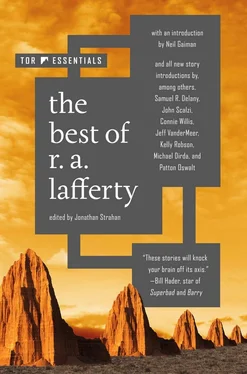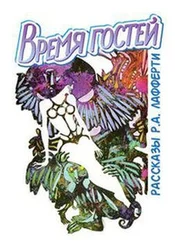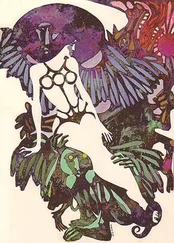And at the bottom of the hole, at the entrance to the den itself, was an encounter which I disbelieved at the time I was seeing and hearing it. There occurred a conversation which I heard with my own ears, they having become transcendent for the moment. It was in the frog-croak Shelni talk between Holly Harkel and the five-year-old Ancient who guarded the coven, and yet it was in a sort of English and I understood it:
“Knockle, knockle.” (This from Holly.)
“Crows in cockle.” (This from the guard.)
“Wogs and wollie.”
“Who you?”
“Holly.”
“What’s a dinning?”
“Coming inning.”
So they let us in. But if you think you can enter a Shelni coven without first riming with the five-year-old Ancient who guards it, then it’s plain that you’ve never been in one of the places. And though the philologists say that the “speech” of the Shelni is meaningless croaking, yet it was never meaningless to Holly, and in flashes it was not meaningless to me. The secret guess of Holly was so.
Holly had insisted that the Shelni spoke English within the limits of their vocal apparatus. And they told her at this very first session that they never had had any language of their own “because no one had ever made one for us”; so they used English as soon as they came to hear it. “We would pay you for the use of it if we had anything to pay you with,” they said. It is frog-croak English, but only the pure of ear can understand it.
I started the recorder and Holly started the Shelni. Quite soon she had them playing on those jug-shaped flutes of theirs. Frog music. Ineffably sad sionnach skirries. Rook, crow, and daw squabbling melody. They were pleasant, weird little pieces of music that sounded as though they were played underwater. It would be hard to imagine them not played under the ground at least.
The tunes were short just as all tunes of children are short. There was no real orchestration, though that should have been possible with the seven flutes differently jugged and tuned. Yet there was true melody in these: short, complete, closed melody, dwarfed perfection. They were underground fugues full of worms’ blood and cool as root cider. They were locust and chaffer and cricket din.
Then Holly got one of the most ancient of the Shelni to tell stories while the jug flutes chortled. Here are the two of them that we recorded that first day. Others who listen to them today say that there is nothing to them but croaking. But I heard them with Holly Harkel, she helped interpret them to me, so I can hear and understand them perfectly in frog-croak English.
Take them, Grisly Posterity! I am not sure that you deserve even this much of the Shelni. The Shelni Who Lost His Burial Tooth
It is told this way.
There was a Shelni who lost his burial tooth before he died. Every Shelni begins life with six teeth, and he loses one every year. Then, when he is very old and has only one tooth left, he dies. He must give the last tooth to the Skokie burial-person to pay for his burial. But this Shelni had either lost two teeth in one year or else he had lived to too great an age.
He died. And he had no tooth left to pay with.
“I will not bury you if you have no tooth left to pay me with,” said the Skokie burial-person. “Should I work for nothing?”
“Then I will bury myself,” said the dead Shelni.
“You don’t know how,” said the Skokie burial-person. “You don’t know the places that are left. You will find that all the places are full. I have agreement that everybody should tell everybody that all the places are full, so only the burial-person may bury. That is my job.”
Nevertheless, the dead Shelni went to find a place to bury himself. He dug a little hole in the meadow, but wherever he dug he found that it was already full of dead Shelnis or Skokies or Frogs. And they always made him put all the dirt back that he had dug.
He dug holes in the valley and it was the same thing. He dug holes on the hill, and they told him that the hill was full too. So he went away crying for he could find no place to lie down.
He asked the Eanlaith whether he could stay in their tree. And they said, no he could not. They would not let any dead folks live in their tree.
He asked the Eise if he could stay in their pond. And they said, no he could not.
They would not allow any dead folks in their pond.
He asked the Sionnach if he could sleep in their den. And they said, no he could not. They liked him when he was alive, but a dead person has hardly any friends at all.
So the poor dead Shelni wanders yet and can find no place to rest his head.
He will wander forever unless he can find another burial tooth to pay with.
They used to tell it so.
* * *
One comment on this burial story: the Shelni do have careful burial. But the burial crypts are plainly dug, not by the six-fingered Shelni, but by the seven-clawed Skokie. There must be substance to the Skokie burial-person. Moreover, the Skokie, though higher on the very low scale than the Shelni, do not bury their own. Furthermore, there are no Shelni remains going back more than about thirty equivalent years. There are no random lying or fossil Shelni at all, though such remains are common for every other species here.
The second story (of the first day). The Shelni Who Turned into a Tree
This is how they tell it.
There was a woman who was neither Shelni nor Skokie nor Frog. She was Sky Woman. One day she came with her child and sat down under the Shelni tree. When she got up to go she left her own child who was asleep and picked up a Shelni child by mistake. Then the Shelni woman came to get her own child and she looked at it. She did not know what was wrong but it was a Sky People child.
“Oh, it has pink skin and flat eyes! How can that be?” the Shelni woman asked. But she took it home with her and it still lives with the Shelni and everyone has forgotten the difference.
Nobody knows what the Sky Woman thought when she got the Shelni child home and looked at it. Nevertheless she kept it, and it grew and was more handsome than any of them.
But when the second year came and the young Shelni was grown, it walked in the woods and said, “I do not feel like a Sky People. But if I am not a Sky People, then what am I? I am not a Duck. I am not a Frog. And if I am a Bird, what kind of Bird am I? There is nothing left. It must be that I am a Tree.” There was reason for this. We Shelni do look a little bit like trees and we feel a little bit like trees.
So the Shelni put down roots and grew bark and worked hard at being a tree. He underwent all the hardships that are the life of a tree. He was gnawed by goats and gobniu; he was rough-tongued by cattle and crom; he was infested by slugs and befouled by the nameless animal. Moreover, parts of him were cut away for firewood.
But he kept feeling the jug music creeping up all the way from his undertoes to his hair and he knew that this music was what he had always been looking for. It was the same jug and tine music that you hear even now.
Then a bird told the Shelni that he was not really a tree but that it was too late for him to leave off growing like a tree. He had brothers and sisters and kindred living in the hole down under his roots, the bird said, and they would have no home if he stopped being a tree.
This is the tree that is the roof of our den where we are even now. This tree is our brother who was lost and who forgot that he was a Shelni.
This is the way it has always been told.
On the second day it was remarkable how much Holly had come to look like a Shelni. And she was hardly taller than they were. Ah well, she has come to look like every sort of creature we have ever studied together. Holly insists that the Shelni have intelligence, and I half agree with her. But the paragraph in the basic manual of this world is against us:
Читать дальше




![Рафаэль Лафферти - Дни, полные любви и смерти. Лучшее [сборник litres]](/books/385123/rafael-lafferti-dni-polnye-lyubvi-i-smerti-luchshe-thumb.webp)
![Рафаэль Лафферти - Лучшее [Сборник фантастических рассказов]](/books/401500/rafael-lafferti-luchshee-sbornik-fantasticheskih-ra-thumb.webp)